Porsche 911 Carrera User Manual
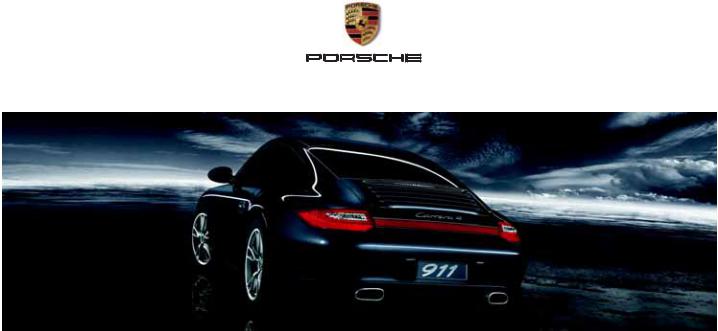
®
911 Carrera
Owner’s Manual
WKD 997 021 10 |
5/09 |
© Dr. Ing. h.c. F. Porsche AG |
|
Porsche, the Porsche crest, 911, Carrera, Targa, PCCB, PCM, PDK, PSM and Tequipment are registered trademarks and the distinctive shapes of Porsche automobiles are trademarks of
Dr. Ing. h.c. F. Porsche AG. All rights reserved.
Printed in Germany
Orientation guides in the
Owner’s Manual
The orientation guides in the Owner’s Manual are highlighted in yellow.
Overall Table of Contents
At the start of the Owner’s Manual you will find an overview of the overall contents of the Owner’s Manual.
Section Contents
There is a summary of topics with the corresponding page numbers at the beginning of each main chapter.
Index
There is a detailed, alphabetical index at the end of this Owner’s Manual.
1

Dear Owner,
We would like to thank you for your purchase of a Porsche Sports car.
Judging by the car you have chosen, you are a motorist of a special breed, and you are probably no novice when it comes to automobiles.
Remember however, as with any vehicle, you should take time to familiarize yourself with your Porsche and its performance characteristics. Always drive within your own unique capabilities as a driver and your level of experience with your Porsche. Ensure that anyone else driving your Porsche does the same. To prevent or minimize injury, always use your safety belts. Never consume alcohol or drugs before or during the operation of your vehicle.
This Owner’s Manual contains a host of useful information. Please take the time to read this manual before you drive your new Porsche. Become familiar with the operation of your Porsche car for maximum safety and operating pleasure. The better you know your Porsche, the more pleasure you will experience driving your new car.
Always keep your Owner’s Manual in the car, and give it to the new owner if you ever sell your Porsche.
A separate Maintenance Booklet explains how you can keep your Porsche in top driving condition by having it serviced regularly.
A separate Warranty and Customer Information Booklet contains detailed information about the warranties covering your Porsche.
For U.S. only:
If you believe that your vehicle has a fault which could cause a crash, injury or death, you should immediately inform the National Highway Traffic Safety Administration (NHTSA) in addition to notifying Porsche Cars North America, Inc. (Porsche Cars N.A.).
If NHTSA receives similar complaints, it may open an investigation, and if it finds that a safety problem exists in a group of vehicles, it may order a recall and remedy campaign. However, NHTSA cannot become involved in individual problems between you and your dealer, or Porsche Cars N.A..
To contact NHTSA, you may call the Vehicle Safety Hotline toll-free at 1-888-327-4236 (TTY: 1-800- 424-9153); go to http://www.safercar.gov; or write to: Administrator, NHTSA, 400 Seventh Street, SW., Washington, DC 20590.
You can also obtain other information about motor vehicle safety from http://www.savercar.gov.
Your car has thousands of parts and components which have been designed and manufactured in accordance with Porsche’s high standards of engineering quality and safety.
Warning!
Any alteration or misuse of the vehicle can lead to accidents and severe or fatal personal injuries.
Any alteration of the vehicle may negate or interfere with those safety features built into the vehicle. Modifications may be carried out on your vehicle only if approved by Porsche. Your Porsche is intended to be used in a safe manner obeying the local laws and in the light of driving conditions faced by you, and in accordance with the instructions provided in this Owner’s Manual.
fDo not misuse your Porsche by ignoring those laws and driving conditions, or by ignoring the instructions in this manual.
Caution!
The fitting of racing tires (e.g. slicks) for sporting events is not approved by Porsche. Very high cornering speeds can be achieved with racing tires. However, the resulting transverse acceleration values would jeopardize the adequate supply of oil to the engine. Porsche therefore will not accept any warranty or accept any liability for damage occurring as a result of non-compliance with this provision.
fDo not fit racing tires (e.g. slicks) for sporting events on your vehicle.
2

Regularly check your vehicle for signs of damage.
Damaged or missing aerodynamic components such as spoilers or underside panels affect the driving behavior and therefore must be replaced immediately.
Your car may have all or some of the components described in this manual.
Should you have difficulty understanding any of the explanations of features or equipment installed in your vehicle, contact your authorized Porsche dealer. He/She will be glad to assist you. Also check with your dealer on other available options or equipment.
Throughout this booklet, left is designated as the driver’s side of the vehicle, and right as the passenger’s side of the vehicle.
Text, illustrations and specifications in this manual are based on the information available at the time of printing.
It has always been Porsche’s policy to continuously improve its products. Porsche, therefore, reserves the right to make changes in design and specification, and to make additions or improvements in its product without incurring any obligation to install them on products previously manufactured.
We wish you many miles of safe and pleasurable driving in your Porsche.
Warning!
For your own protection and longer service life of your car, please follow all operating instructions and special warnings. These special warnings use the safety alert symbol, followed by the words
Danger, Warning and Caution. These special warnings contain important messages regarding your safety and/or the potential for damage to your Porsche. Ignoring them could result in serious mechanical failure, serious personal injury or death.
fDo not alter your Porsche. Any alteration could create dangerous conditions or defeat safety engineering features built into your car.
fDo not misuse your Porsche. Use it safely, and consistently with the law, according to the driving conditions, and the instructions in this manual.
Alteration or misuse of your Porsche could cause accidents and serious personal injury or death.
Note to owners
In Canada, this manual is also available in French. To obtain a copy contact your dealer or write to:
Note aux proprietaires
Au Canada on peut se procurer un exemplaire de ce Manuel en français auprès du concessionaire ou du:
Porsche Cars Canada, Ltd. Automobiles Porsche Canada, LTEE
5925 Airport Road Suite 420 Mississauga, Ontario Canada L4V 1W1
Telephone number for customer assistance: 1-800-PORSCHE / Option 3
3
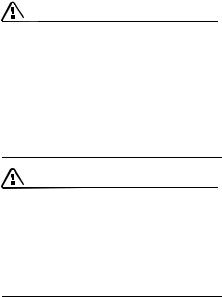
Sport tires
Sport tires (ultra high performance tires) are approved for use on public highways and comply with all statutory requirements and safety criteria.
The design of the tire is also geared towards use on racing circuits (driver safety training courses, sports driving schools, Club Sport events) and provides distinct advantages here in terms of dry grip and wear compared to conventional road tires.
The major features are a reduced tread depth and a special tread pattern and carcass.
The design features of this sports tire result in the following effects compared with other summer tires when used under normal driving conditions:
–Sport tires have a smaller tread depth, and thus can reach their wear limit sooner.
As with all tires, the attainable mileage depends on the individual driving style and the conditions of use.
–Exercise caution when driving on wet roads, paying special attention to hydroplaning situations (stagnant water, puddles, lane grooves). Sport tires have a lower tread depth than normal tires and you must therefore adapt speed accordingly when driving on wet surfaces.
–The driver’s skill level must be commensurate with the vehicle performance levels in the upper range limits, due to increased safety risks in the upper range limits.
fAt oudside temperatures below 45 °F (7 °C) change to snow tires.
fNotify anyone using your car of these characteristics and possible effects.
Danger!
Risk of accident through loss of road surface contact, control over the vehicle and braking ability, leading to serious personal injury or death.
The reduced tire tread depth means that there is an increased risk of aquaplaning on wet roads.
fWhen driving on wet or mud-covered roads reduce speed significantly.
Danger!
Risk of accident from worn tires.
Sport tires have a smaller tread depth, and thus can reach their wear limit sooner.
It is important to check tire wear frequently to avoid risk of serious personal injury or death from worn tires.
f Check tire wear frequently.
Porsche Ceramic Composite Brake (PCCB)
f Please see the chapter “BRAKES” on Page 58.
The high-performance brake system is designed for optimal braking effect at all speeds and temperatures.
Certain speeds, braking forces and ambient conditions (such as temperature and humidity) therefore might cause brake noises.
Wear on the different components and braking system, such as brake pads and brake discs, depends to a great extent on the individual driving style and the conditions of use and therefore cannot be expressed in actual miles on the road.
The values communicated by Porsche are based on normal operation adapted to traffic. Wear increases considerably when the vehicle is driven on race tracks or through an aggressive driving style.
fPlease consult an authorized Porsche dealer about the current guidelines in effect before such use of your vehicle.
4
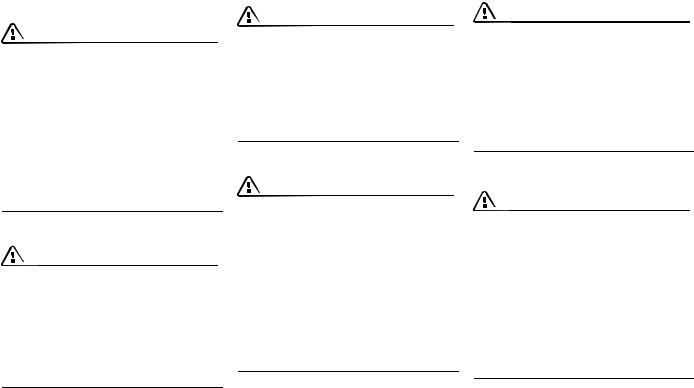
Setting and operating vehicle components when driving
Warning!
There is a danger of accident if you set or operate the on-board computer, radio, navigation system, telephone or other equipment when driving.
This could distract you from the traffic and cause you to lose control of the vehicle resulting in serious personal injury or death.
fOperate the components while driving only if the traffic situation allows you to do so safely.
fCarry out any complicated operating or setting procedures only with the vehicle stationary.
Portable Fuel Containers
Danger!
Portable fuel containers may leak, whether they are full or partially empty. Fuel leaking from a portable container carried in your vehicle could, in case of an accident, cause a fire or explosion, resulting in serious personal injury or death.
fNever carry additional fuel in portable containers in your vehicle.
Ground Clearance
Caution!
Risk of damage. The vehicle may touch the ground as a result of reduced ground clearance.
fDrive carefully and slowly on steep slopes (e.g. parking lots, curbs, uneven roads, lifting platforms etc.).
f Avoid steep ramps.
Engine Exhaust
Danger!
Engine exhaust is dangerous if inhaled. Engine exhaust fumes have many components which you can smell. They also contain carbon monoxide (CO), which is a colorless and odorless gas.
Carbon monoxide can cause unconsciousness and even death if inhaled.
fNever start or let the engine run in an enclosed, unventilated area.
It is not recommended to sit in your car for prolonged periods with the engine on and the car not moving.
California Proposition 65 Warning
Warning!
Engine exhaust, some of its constituents, and certain vehicle components contain or emit chemicals known to the State of California to cause cancer and birth defects or other reproductive harm. In addition, certain fluids contained in vehicles and certain products of component wear contain or emit chemicals known to the State of California to cause cancer and birth defects or other reproductive harm.
Hot Exhaust Pipes
Warning!
Risk of burn injury when standing near or coming into contact with the exhaust pipe.
The exhaust pipe is hot when the vehicle is running and remains hot for some time after the vehicle is turned off.
f
5

Table of Contents |
|
Sport tires..................................................... |
4 |
Porsche Ceramic Composite Brake (PCCB)...... |
4 |
Setting and operating vehicle components |
|
when driving .................................................. |
5 |
Ground Clearance .......................................... |
5 |
Before driving off... ....................................... |
8 |
Break in hints for the first |
|
2,000 miles/3,000 kilometers...................... |
10 |
Operation, Safety.............................. |
13 |
Keys ........................................................... |
15 |
Security Wheel Bolts .................................... |
15 |
Doors ......................................................... |
18 |
Central Locking ........................................... |
19 |
Alarm System, |
|
Passenger Compartment Monitoring ............. |
23 |
Power Windows ........................................... |
25 |
Mirrors........................................................ |
27 |
Rear Window Defogger, Door Mirror Heating .. |
29 |
Seat Adjustment and Head Restraints ............ |
30 |
Seat Memory............................................... |
33 |
Heated Seats .............................................. |
35 |
Seat Ventilation............................................ |
36 |
Rear Seat Backrests .................................... |
37 |
Steering Wheel Adjustment ........................... |
37 |
Steering Wheel Heating ................................ |
38 |
Multi-Functional Steering Wheel ..................... |
39 |
Sun Visors................................................... |
40 |
Safety Belts................................................. |
41 |
Airbag Systems ........................................... |
44 |
Child Restraint Systems................................ |
50 |
6 Table of Contents |
|
LATCH System |
|
Child seat bracket on the passenger’s seat .... |
54 |
Child Restraint Anchorages ........................... |
55 |
Rollover Protection System ........................... |
56 |
Sports Exhaust System ................................ |
57 |
Parking Brake .............................................. |
57 |
Brakes ........................................................ |
58 |
ABS Brake System (Antilock Brake System).... |
61 |
Clutch Pedal ................................................ |
62 |
Porsche Traction Management (PTM)............. |
63 |
Sport Mode ................................................. |
64 |
Porsche Stability Management (PSM)............. |
66 |
Porsche Active Suspension Management |
|
(PASM) ........................................................ |
69 |
Retractable Rear Spoiler............................... |
69 |
Interior Lights .............................................. |
71 |
Parking Aids ................................................ |
72 |
Ignition/Starter Switch with |
|
anti-theft Steering Lock................................. |
74 |
Starting Procedures ..................................... |
77 |
Stopping Engine........................................... |
78 |
Emergency Flasher Switch ............................ |
79 |
Light Switch................................................. |
80 |
Welcome Home Lighting ............................... |
81 |
Automatic Headlight Beam Adjustment........... |
81 |
Turn Signal / Headlight Dimmer / |
|
Parking light / Flasher Lever ......................... |
82 |
Windshield Wiper / Washer Lever .................. |
83 |
Automatic Speed Control .............................. |
86 |
Cupholder ................................................... |
88 |
Ashtray ....................................................... |
89 |
Cigarette Lighter.......................................... |
90 |
Storage in the Passenger Compartment ....... |
91 |
Luggage Compartment Lid and |
|
Engine Compartment Lid ............................. |
93 |
Luggage Compartment (Vehicles without |
|
Porsche Traction Management PTM)............. |
95 |
Luggage Compartment (Vehicles with |
|
Porsche Traction Management PTM)............. |
96 |
Trunk Entrapment........................................ |
97 |
Porsche Communication Management (PCM). 98 |
|
Car Telephone and Aftermarket Alarms ....... |
100 |
iPod, USB and AUX.................................... |
101 |
Fire Extinguisher ....................................... |
102 |
HomeLink ................................................. |
103 |
Automatic Air Conditioning System, |
|
Heated Rear Window/ |
|
Door Mirror Heating........................ |
105 |
Automatic Air Conditioning System ............. |
106 |
Central and Side Vents............................... |
109 |
Fresh-air Intake ......................................... |
109 |
Heated Rear Window/Door Mirror Heating ... |
110 |
Instruments, On-Board Computer, |
|
Warnings ....................................... |
111 |
Instrument Panel USA Models..................... |
112 |
Instrument Panel Canada Models................ |
114 |
Engine Oil Temperature.............................. |
116 |
Automatic Speed Control Indicator light ...... |
116 |
Instrument Illumination ............................... |
116 |
Trip Odometer........................................... |
117 |

Speedometer ............................................ |
118 |
Changing over between Miles / Kilometers .. |
118 |
Tachometer ............................................... |
119 |
Turn Signal Indicator Light .......................... |
119 |
High Beam Indicator Light........................... |
119 |
Gear Shift Indicator “A” |
|
(in vehicles with manual transmission).......... |
119 |
Cooling System ......................................... |
120 |
Porsche Doppelkupplung (PDK) ................... |
121 |
Fuel .......................................................... |
122 |
Clock ........................................................ |
123 |
Outside Temperature .................................. |
123 |
Engine Oil Pressure.................................... |
124 |
Check Engine (Emission Control) ................. |
125 |
On-Board Computer (BC) ............................ |
126 |
Warnings on the instrument panel |
|
and the on-board computer......................... |
158 |
Shifting Gears................................. |
167 |
Manual Transmission, Clutch....................... |
168 |
Drive-Off Assistant ..................................... |
169 |
Porsche Doppelkupplung (PDK) ................... |
170 |
Mobile Roofs .................................. |
177 |
Lifting/Sliding Roof .................................... |
178 |
Convertible Top ......................................... |
181 |
Emergency operation of the convertible top . 183 |
|
Windstop................................................... |
190 |
Hardtop .................................................... |
194 |
Targa ........................................................ |
200 |
Roof Transport System............................... |
204 |
Maintenance, Car Care ................... |
205 |
Exercise Extreme Caution when Working |
|
on your Vehicle .......................................... |
206 |
Coolant Level............................................. |
207 |
Engine Oil.................................................. |
208 |
Engine Oil Level ......................................... |
208 |
Engine Oil Recommendation........................ |
210 |
Brake Fluid Level........................................ |
212 |
Fuel Economy ............................................ |
214 |
Operating your Porsche in other Countries... |
214 |
Fuel Recommendations .............................. |
216 |
Portable Fuel Containers............................. |
217 |
Fuel Evaporation Control............................. |
217 |
Emission Control System ............................ |
218 |
How Emission Control Works ...................... |
219 |
Washer Fluid.............................................. |
220 |
Power Steering .......................................... |
221 |
Air Filter .................................................... |
222 |
Combination Filter ...................................... |
222 |
Fluids/Oils for Manual Transmission |
|
and Porsche Doppelkupplung (PDK)............. |
222 |
Wiper Blades ............................................. |
223 |
Car Care Instructions.................................. |
224 |
Lifting the Vehicle with a Lifting Platform or |
|
Garage Lift ............................................... |
254 |
Spacers 911 Carrera, 911 Carrera S ......... |
255 |
Electrical System ...................................... |
257 |
Battery ..................................................... |
261 |
Replacing the remote-control battery .......... |
266 |
Emergency Starting with Jumper Cables ..... |
267 |
Bulb chart................................................. |
269 |
Lights, Replacing Bulbs.............................. |
269 |
Headlights ................................................ |
270 |
Number Plate Light.................................... |
277 |
Changing Light-Emitting Diodes and |
|
Long-Life Bulbs ......................................... |
277 |
Adjusting Headlights .................................. |
278 |
Towing ..................................................... |
280 |
Vehicle Identification, |
|
Technical Data ............................... |
283 |
Vehicle Identification .................................. |
284 |
Technical Data .......................................... |
286 |
Diagrams ................................................. |
299 |
Practical Tips, Emergency Service... 233
Exercise Extreme Caution when Working |
|
on your Vehicle .......................................... |
234 |
Tires/Wheels ............................................. |
235 |
Loading Information ................................... |
246 |
Wheel Bolts ............................................... |
248 |
Changing a wheel....................................... |
249 |
Flat Tire..................................................... |
251 |
Table of Contents 7
Dear Porsche Owner
A lot has gone into the manufacture of your Porsche, including advanced engineering, rigid quality control and demanding inspections. These engineering and safety features will be enhanced by you...
the safe driver...
–who knows his/her car and all controls,
–who maintains the vehicle properly,
–who uses driving skills wisely and always drives within her/his own capabilities and the level of familiarity with the vehicle.
You will find helpful hints in this manual on how to perform most of the checks listed on the following pages.
If in doubt, have these checks performed by your authorized Porsche dealer.
Before driving off...
Check the following items first
fTurn the engine off before you attempt any checks or repairs on the vehicle.
fBe sure the tires are inflated correctly. Check tires for damage and tire wear.
fSee that wheel bolts are properly tightened and not loose or missing.
fCheck engine oil level, add if necessary. Make it a habit to have engine oil checked with every fuel filling.
fCheck all fluid levels such as windshield washer and brake fluid levels.
fBe sure the vehicle battery is well charged and cranks the engine properly.
fCheck all doors and lids for proper operation and latch them properly.
fCheck, and if necessary replace worn or cracked wiper blades.
fSee that all windows are clear and unobstructed.
fCheck air intake slots and area between luggage compartment lid and windshield. Ensure that these areas are free of snow and ice, so the heater and the windshield wipers work properly.
8 Before driving off...
fIf a child will be riding in the vehicle, check child seat/child seat restraint system to ensure that restraints are properly adjusted.
fChild restraint systems will not fit into the Sports bucket seat.
Do not install a child restraint system in the Sports bucket seat.
The Sports bucket seat cannot be equipped with the LATCH system and thus the airbag system cannot be manually deactivated.
fCheck all exterior and interior lights for operation and that the lenses are clean.
fCheck the headlights for proper aim, and if necessary, have them adjusted.
f Check under the vehicle for leaks.
f Be sure all luggage is stowed securely.
Emergency equipment
It is good practice to carry emergency equipment in your vehicle.
Some of the items you should have are:
window scraper, snow brush, container or bag of sand or salt, emergency light, small shovel, firstaid kit, etc.
In the driver’s seat...
f Check operation of the horn.
fPosition seat for easy reach of foot pedals and controls.
To reduce the possibility of injury from the airbag deployment, you should always sit back as far from the steering wheel as is practical, while still maintaining full vehicle control.
f Adjust the inside and outside rear view mirrors. f Buckle your safety belts.
f Check operation of the foot and parking brake.
fCheck all warning and indicator lights with ignition on and engine not running.
fStart engine and check all warning displays for warning symbols.
f Never leave an idling car unattended.
fLock doors from inside, especially with children in the car to prevent inadvertent opening of doors from inside or outside.
Drive with doors locked.
On the road...
fNever drive after you have consumed alcohol or drugs.
f Always have your safety belt fastened.
fAlways drive defensively. Expect the unexpected.
f Use signals to indicate turns and lane changes.
fTurn on headlights at dusk or when the driving conditions warrant it.
fAlways keep a safe distance from the vehicle in front of you, depending on traffic, road and weather conditions.
fReduce speed at night and during inclement weather.
Driving in wet weather requires caution and reduced speeds, particularly on roads with standing water, as the handling characteristics of the vehicle may be impaired due to hydroplaning of the tires.
fAlways observe speed limits and obey road signs and traffic laws.
fWhen tired, get well off the road, stop and take a rest. Turn the engine off. Do not sit in the vehicle with engine idling.
Please see the chapter “ENGINE EXHAUST” on Page 5.
fWhen parked, always set the parking brake. Move the PDK selector lever to ”P“ or the gearshift lever to reverse or first gear.
On hills also turn the front wheels toward the curb.
fWhen emergency repairs become necessary, move the vehicle well off the road. Turn on the emergency flasher and use other warning devices to alert other motorists. Do not park or operate the vehicle in areas where the hot exhaust system may come in contact with dry grass, brush, fuel spill or other flammable material.
fMake it a habit to have the engine oil checked with every refueling.
Before driving off... 9
Break in hints for the first 2,000 miles/3,000 kilometers
The following tips will be helpful in obtaining optimum performance from your new Porsche.
Despite the most modern, high-precision manufacturing methods, the moving parts must still wear in with each other. This wearing-in occurs mainly in the first 2,000 miles/3,000 kilometers.
Therefore:
f Preferably take longer trips.
fAvoid frequent cold starts with short-distance driving whenever possible.
f Avoid full throttle starts and abrupt stops.
fDo not exceed maximum engine speed of 4,200 rpm (revolutions per minute).
fDo not run a cold engine at high rpm either in Neutral or in gear.
fDo not let the engine labor, especially when driving uphill. Shift to the next lower gear in time (use the most favorable rpm range).
fNever lug the engine in high gear at low speeds. This rule applies at all times, not just during the break-in period.
fDo not participate in motor racing events, sports driving schools, etc. during the first 2,000 miles/3,000 kilometers.
There may be a slight stiffness in the steering, gear-shifting or other controls during the break-in period which will gradually disappear.
Break in brake pads and brake discs
New brake pads and discs have to be “broken in”, and therefore only attain optimal friction when the car has covered several hundred miles or km.
The slightly reduced braking ability must be compensated for by pressing the brake pedal harder. This also applies whenever the brake pads and brake discs are replaced.
New tires
New tires do not have maximum traction. They tend to be slippery.
fBreak in new tires by driving at moderate speeds during the first 60 to 120 miles/100 to 200 km. Longer braking distances must be anticipated.
Engine oil and fuel consumption
During the break-in period oil and fuel consumption may be higher than normal.
As always, the rate of oil consumption depends on the quality and viscosity of oil, the speed at which the engine is operated, the climate and road conditions, as well as the amount of dilution and oxidation of the lubricant.
fMake a habit of checking engine oil with every refueling, add if necessary.
10 Before driving off...
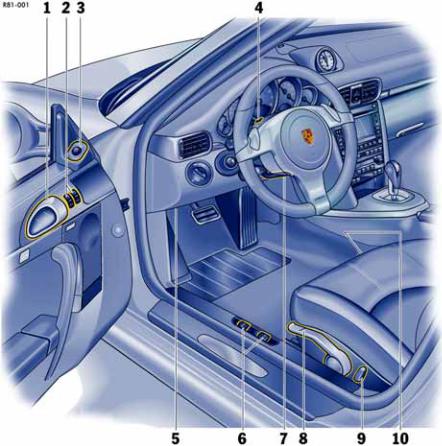
1 Inner door handle, Page 18
2 Power windows, Page 25
3 Door mirror control, Page 27
4Hands-free microphone
5Diagnostic socket (OBD)
6Front and rear lid release, Page 93
7Steering-wheel adjustment, Page 37
8Seat height adjustment, Page 30
9Backrest angle adjustment, Page 30 10 Seat fore-and-aft adjustment, Page 30
Before driving off... 11
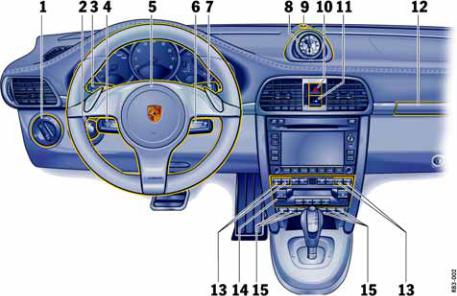
1 Light switch, Page 80
2 Ignition/starter switch, Page 74
3 Turn signal/headlight dimmer, flasher lever, Page 82
4 Operating lever for on-board computer, Page 128
5 Horn
6 Operating lever for automatic speed control, Page 86
7 Wiper/washer lever, rear window wiper, Page 83
8 Stopwatch, Page 138
9 Interior temperature sensor
10 Emergency flasher switch, Page 79
11 Central locking button, readiness display for alarm system, Page 19
12 Cupholder, Page 88
13 Seat heating/Seat ventilation left/right, Page 35
14 Operating panel for air conditioning, Page 108
15 Sport/Sport Plus program, Page 64 Rear spoiler, Page 69
Porsche Active Suspension Management (PASM), Page 69
Porsche Stability Management (PSM), Page 66
Sports exhaust system, Page 57
12 Before driving off...

Operation, Safety
Keys ........................................................... |
15 |
Porsche Stability Management (PSM)............. |
66 |
Fire Extinguisher ........................................ |
102 |
Security Wheel Bolts .................................... |
15 |
Porsche Active Suspension Management |
|
HomeLink.................................................. |
103 |
Doors ......................................................... |
18 |
(PASM) ........................................................ |
69 |
|
|
Central Locking ........................................... |
19 |
Retractable Rear Spoiler............................... |
69 |
|
|
Alarm System, |
|
Interior Lights .............................................. |
71 |
|
|
Passenger Compartment Monitoring ............. |
23 |
Parking Aids ................................................ |
72 |
|
|
Power Windows ........................................... |
25 |
Ignition/Starter Switch with |
|
|
|
Mirrors........................................................ |
27 |
anti-theft Steering Lock ................................ |
74 |
|
|
Rear Window Defogger, Door Mirror Heating .. |
29 |
Starting Procedures ..................................... |
77 |
|
|
Seat Adjustment and Head Restraints ............ |
30 |
Stopping Engine .......................................... |
78 |
|
|
Seat Memory............................................... |
33 |
Emergency Flasher Switch............................ |
79 |
|
|
Heated Seats .............................................. |
35 |
Light Switch ................................................ |
80 |
|
|
Seat Ventilation............................................ |
36 |
Welcome Home Lighting ............................... |
81 |
|
|
Rear Seat Backrests .................................... |
37 |
Automatic Headlight Beam Adjustment .......... |
81 |
|
|
Steering Wheel Adjustment ........................... |
37 |
Turn Signal / Headlight Dimmer / |
|
|
|
Steering Wheel Heating ................................ |
38 |
Parking light / Flasher Lever ......................... |
82 |
|
|
Multi-Functional Steering Wheel ..................... |
39 |
Windshield Wiper / Washer Lever .................. |
83 |
|
|
Sun Visors................................................... |
40 |
Automatic Speed Control.............................. |
86 |
|
|
Safety Belts................................................. |
41 |
Cupholder ................................................... |
88 |
|
|
Airbag Systems ........................................... |
44 |
Ashtray ....................................................... |
89 |
|
|
Child Restraint Systems................................ |
50 |
Cigarette Lighter.......................................... |
90 |
|
|
LATCH System |
|
Storage in the Passenger Compartment ........ |
91 |
|
|
Child seat bracket on the passenger’s seat.... |
54 |
Luggage Compartment Lid and |
|
|
|
Child Restraint Anchorages........................... |
55 |
Engine Compartment Lid .............................. |
93 |
|
|
Rollover Protection System........................... |
56 |
Luggage Compartment (Vehicles without |
|
|
|
Sports Exhaust System ................................ |
57 |
Porsche Traction Management PTM).............. |
95 |
|
|
Parking Brake.............................................. |
57 |
Luggage Compartment (Vehicles with |
|
|
|
Brakes ........................................................ |
58 |
Porsche Traction Management PTM).............. |
96 |
|
|
ABS Brake System (Antilock Brake System) ... |
61 |
Trunk Entrapment ........................................ |
97 |
|
|
Clutch Pedal ................................................ |
62 |
Porsche Communication Management (PCM).. |
98 |
|
|
Porsche Traction Management (PTM)............. |
63 |
Car Telephone and Aftermarket Alarms ........ |
100 |
|
|
Sport Mode ................................................. |
64 |
iPod, USB and AUX .................................... |
101 |
|
|
|
|
|
|
Operation, Safety |
13 |
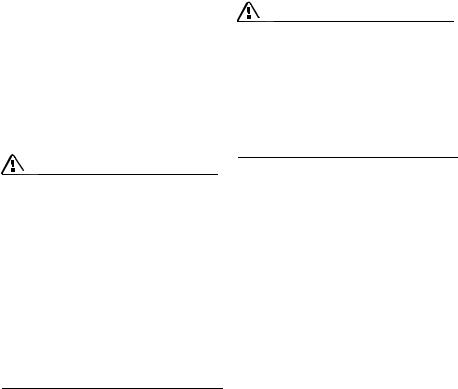
Never invite car theft!
An unlocked car with the key in the ignition lock invites car theft.
A steering wheel lock and a gong alarm are standard equipment in your Porsche.
The gong alarm will sound if you open the driver’s door while the key is still in the ignition lock. It is your reminder to pull the key out of the ignition lock and to lock the doors.
Warning!
Any uncontrolled movement of the vehicle may result in property damage, serious personal injury or death.
Never leave your vehicle unattended with the key in the ignition lock, especially if children and/or pets are left unattended in the vehicle. They can operate power windows and other controls. If the engine is left running, they may accidentally engage the shift lever. Serious personal injury or death could result from loss of control of the vehicle.
f Always remove the ignition key. f Always set the parking brake.
f Lock the doors with the remote control.
Warning!
Risk of a serious accident.
The steering column will lock when you remove the key while you are driving or as the car is rolling to a stop. You will not be able to steer the car.
Serious personal injury or death could result from loss of control of the vehicle.
fNever remove the key from the steering lock while you are driving.
To protect your vehicle and your possessions from theft, you should always proceed as follows when leaving your vehicle:
f Close windows.
f Close lifting/sliding roof
fClose convertible top (with the convertible top open, the passenger compartment monitoring system is always switched off)
fClose the sliding glass roof (Targa) (with the sliding glass roof open, the passenger compartment monitoring system is always switched off)
f Remove ignition key. f Engage steering lock.
f Lock glove compartment.
fRemove valuables (e.g. car documents, telephone, house keys) from the car.
f Lock doors.
14 Operation, Safety
Keys
fPlease see the chapter “ALARM SYSTEM, PASSENGER COMPARTMENT MONITORING” on Page 23.
fPlease see the chapter “CENTRAL LOCKING” on Page 19.
Two car keys are supplied with your Porsche. These keys operate all the locks on your vehicle.
fBe careful with your car keys: do not part with them except under exceptional circumstances.
fTo avoid battery run-down, always remove the ignition key from the ignition lock.
Replacement keys
Replacement car keys can be obtained only from your authorized Porsche dealer, and this can sometimes be very time-consuming.
You should therefore always keep a spare key on your person.
Keep it in a safe place (e.g. wallet), but under no circumstances in or on the vehicle.
The key codes of new keys have to be “reported” to the car control unit by your authorized Porsche dealer.
A total of 6 car keys can be reported to the control unit.
Disabling key codes
If a key is lost, the key codes can be disabled by an authorized Porsche dealer.
All the remaining car keys are required for this purpose.
Disabling the code ensures that the car can be started only using authorized keys.
Note
fPlease note that the other locks can still be opened with the disabled key.
Immobilizer
There is a transponder (an electronic component) in the key grip, containing a stored code.
When the ignition is switched on, the ignition lock checks the code.
The immobilizer can be deactivated and the engine started only using an authorized ignition key.
Switching off the immobilizer
f Insert the ignition key into the ignition lock.
If the ignition is left on for more than 2 minutes without the engine being started, the immobilizer is switched on again.
fIf this happens, turn the ignition key back to position 3 (ignition off) before starting the engine. The immobilizer is switched off again, and the engine can be started.
fPlease see the chapter “IGNITION/STARTER SWITCH WITH ANTI-THEFT STEERING LOCK” on Page 74.
Switching on the immobilizer f Remove ignition key.
Security Wheel Bolts
fIf wheels have to be removed during a workshop visit, do not forget to hand over the socket for the security wheel bolts along with the car key.
Operation, Safety 15
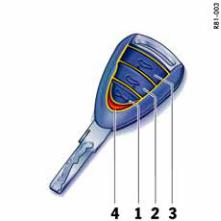
1 - Central locking button
2 - Luggage compartment lid button
3 - Button for glass rear hatch (Targa)
4 - Light-emitting diode
16 Operation, Safety
Key with Radio Remote Control
Unlocking the vehicle
f Press button 1.
Locking the vehicle
f Press button 1.
Switching off the alarm system if it is triggered accidentally
f Press button 1.
Unlocking luggage compartment lid or glass rear hatch (Targa)
fLuggage compartment lid: Press button 2 for approx. two seconds.
fGlass rear hatch (Targa): Press button 3 for approx. two seconds.
If the vehicle was locked, it is unlocked simultaneously with the luggage compartment/glass rear hatch (Targa).
In vehicles with seat memory the stored seat and door mirror positions are automatically set.
The vehicle will be locked again approx.
80 seconds after the luggage compartment/ glass rear hatch (Targa) is closed if none of the doors was opened.
Note
Your authorized Porsche dealer can program further types of unlocking for the luggage compartment/glass rear hatch (Targa).
Type 1
The relocking time of the doors can be adjusted to suit your individual requirements:
10 - 100 seconds.
Type 2
The doors stay locked when the luggage compartment/glass rear hatch (Targa) is unlocked.
The remote-control standby function switches off after 7 days
If the vehicle is not started or unlocked with the remote control within 7 days, the remote control standby function is switched off (to prevent discharging of the vehicle battery).
1.In this case, unlock the driver’s door with the key at the door lock.
Leave the door closed in order to prevent the alarm system from being triggered.
2.Press button 1 on the remote control.
The remote control is now activated again and the alarm system is switched off.
Operational readiness of the remote control interrupted
Encoded data is transmitted to the vehicle each time the wireless remote control is operated. If the remote control is operated too often outside the range of the vehicle, this can result in the central locking system no longer responding.
In this case, the remote control and vehicle must be synchronized.
Carrying out the synchronization
1.Unlock the driver's door with the key at the door lock.
2.Open driver’s door and insert the ignition key into the ignition lock within 10 seconds to prevent the alarm system from being triggered.
3.With the key inserted, press and hold button 1 on the remote control for approx. 5 seconds. The synchronization is now complete.
Operation, Safety 17
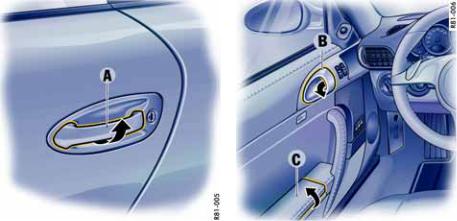
Door storage tray
Opening storage tray f Open the cover C.
Keep the door storage tray C closed while driving for safety reasons.
Doors
If the door windows are closed, they will be automatically opened by a few millimeters when the doors are opened and, when the doors are closed, they will be closed again. This makes it easier to open and close the doors and protects the seals.
fTherefore, you should pull the door handle slowly so that the door window can be lowered before the door is opened.
Opening doors from outside
f Unlock vehicle with the remote control. f Slowly pull door handle A.
18 Operation, Safety
Opening unlocked doors from inside
f Slowly pull door handle B.
Opening locked doors from inside
f Slowly pull door handle B twice.
fPlease see the chapter “LOCKING CONDITIONS” on Page 20.

Central Locking
This device complies with: Part 15 of the FCC Rules RSS-210 of Industry Canada.
Operation is subject to the following two conditions:
1.This device may not cause harmful interference, and
2.this device must accept any interference received, including interference that may cause undesired operation.
Note
The manufacturer is not responsible for any radio or TV interference caused by unauthorized modifications to this equipment.
Such modification could void the user’s authority to operate the equipment.
Warning!
Any changes or modifications not expressly approved by Porsche could void the user’s authority to operate this equipment.
fPlease see the chapter “LOAD SWITCH-OFF AFTER 2 HOURS OR 7 DAYS” on Page 258.
fPlease see the chapter “SEAT MEMORY” on Page 33.
Both car doors and the filler flap can be centrally unlocked or locked with the remote control.
The vehicle cannot be locked if the driver’s door is not completely closed.
A short signal from the alarm horn will draw your attention to the fact that the following components are not completely closed when you try to lock the vehicle:
–Driver’s door (the vehicle cannot be locked if the driver’s door is not completely closed).
–Passenger’s door
–Luggage compartment lid
–Engine compartment lid
–Glass rear hatch (Targa)
–Glove compartment
Unlocking the vehicle by using the key in the door lock and opening the door may activate the alarm system within 10 seconds.
Note
fOn vehicles with the Sport Chrono Package Plus, the PCM can be used to activate automatic door locking.
Please observe the chapter “Individual Memory” in the separate PCM operating instructions.
Automatic relocking
If the car is unlocked by remote control and none of the car doors is opened within approx.
100 seconds, automatic relocking takes place. This relocking time can be adapted to your individual requirements (10 - 100 seconds) by an authorized Porsche dealer.
Operation, Safety 19
Locking conditions
fLock car once.
The doors cannot be opened from the outside. Alarm system and passenger compartment monitoring are switched on.
If a person or animal remains in the vehicle:
fQuickly lock car twice.
The doors cannot be opened from the outside. The passenger compartment monitoring is switched off.
Unlocking the door with the inner door handle
Any person remaining in the locked car can open the door with the inner door handle:
1.Pull inner door handle once to unlock door lock.
2.Pull inner door handle again to open door.
Note
fInform any person remaining in the car that the alarm system will be triggered if the door is opened.
Malfunction of the remote control
The remote control may not function correctly due to local radio wave interference. The vehicle will then not lock properly.
This can be identified by the missing locking sound and the missing check-back signal of the emergency flasher.
If this should occur:
f Lock the vehicle with the key in the door.
Emergency operation – opening
fUnlock the driver’s door with the key at the door lock.
Open door within 20 seconds and insert the ignition key into the ignition lock within
10 seconds to prevent the alarm system from being triggered.
Note on operation
If the door is not opened within approx.
20 seconds, automatic relocking takes place. The alarm system will be triggered by the next unlocking of the door:
fInsert the ignition key into the ignition lock to switch off the alarm system.
Emergency operation – closing
fLock the driver’s door with the key at the door lock.
If there is a defect in the central locking system, all functioning elements of the central locking system will be locked.
The alarm system is switched on.
The passenger compartment monitoring system is switched off.
The fault should be remedied immediately at an authorized Porsche dealer.
20 Operation, Safety
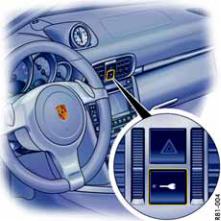
Indication by emergency flasher and alarm horn
If the remote control is used for unlocking or locking, a response is provided by the emergency flasher:
–Unlocking – single flash.
–Locking – double flash.
–Locking twice – continuous illumination for approx. 2 seconds.
The passenger compartment monitoring is switched off.
Fault indication
A double horn signal during locking indicates a defect in the central locking or alarm system. Have the defect remedied at an authorized Porsche dealer.
Overload protection
If the central locking system is operated more than ten times within a minute, further operation is blocked for 30 seconds.
Central locking button
The central locking button on the dashboard lets you lock and unlock both doors electrically.
Note
If the doors are locked with the key or remote control, they can not be opened by pressing the central locking button.
Locking
fPress the central locking button.
Indicator light in the button lights up if ignition is on.
Unlocking
fPress the central locking button. Indicator light goes out.
If the doors were locked with the central locking button, they can be opened by pulling the inner door handle:
1.Pull inner door handle once to unlock door lock.
2.Pull inner door handle again to open door.
Operation, Safety 21

Automatic door locking
Your authorized Porsche dealer can program diverse types of automatic door locking in the control unit of the central locking system:
Type 1
Doors lock automatically when the ignition is switched on.
Type 2
Doors lock automatically when a speed of 3 - 6 mph (5 - 10 km/h) is exceeded.
Type 3
Doors lock automatically when the ignition is switched on. If doors are opened with the engine running, they lock again automatically when a speed of 3 - 6 mph (5 - 10 km/h) is exceeded.
Type 4
The doors do not lock automatically.
Note
Automatically locked doors can be unlocked with the central locking button or opened by pulling on the inside door handle twice.
fOn vehicles with the Sport Chrono Package Plus, the PCM can be used to activate automatic door locking.
Please observe the chapter “Individual Memory” in the separate PCM operating instructions.
Warning!
In an emergency situation where you need to exit the car through an automatically locked door, remember the following procedure to open the door.
fUnlock the doors by pressing the central locking button or
fpull the inside door handle twice to open the door.
22 Operation, Safety
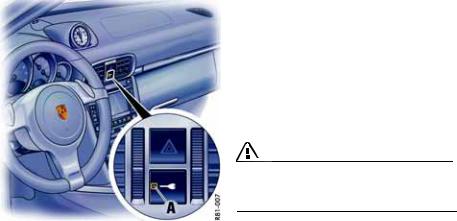
A - Light-emitting diode for alarm system
Alarm System,
Passenger Compartment
Monitoring
This device complies with: Part 15 of the FCC Rules RSS-210 of Industry Canada.
Operation is subject to the following two conditions:
1.This device may not cause harmful interference, and
2.this device must accept any interference received, including interference that may cause undesired operation.
Note
The manufacturer is not responsible for any radio or TV interference caused by unauthorized modifications to this equipment.
Such modification could void the user’s authority to operate the equipment.
Warning!
Any changes or modifications not expressly approved by Porsche could void the user’s authority to operate this equipment.
The alarm system and passenger compartment monitoring system are switched on when the doors are locked with the key or remote control.
fPlease see the chapter “CENTRAL LOCKING” on Page 19.
Unlocking the vehicle by using the key in the door lock and opening the door may activate the alarm system within 10 seconds.
Switching off the alarm system if it is triggered accidentally
f Unlock the vehicle with the remote control.
The alarm system and passenger compartment monitoring system are switched off automatically when the doors are unlocked.
Cabriolet, Targa
The passenger compartment monitoring system is always switched off when the convertible top or sliding glass roof (Targa) is open.
Function indication
If the alarm system is activated, light-emitting diode A in the central locking switch flashes.
If, after locking, the light-emitting diode does not flash or, after ten seconds, it emits double flashes, then not all alarm contacts are closed.
Additionally, a brief horn signal sounds.
When the doors are unlocked, the alarm system and passenger compartment monitoring system are switched off and the light-emitting diode goes off.
Operation, Safety 23
When the alarm is armed, the following areas are monitored
–Doors
–Luggage compartment lid
–Engine compartment lid
–Convertible-top lock (Cabriolet)
–Glass rear hatch (Targa)
–Glove compartment
–Passenger compartment
If one of these alarm contacts is interrupted, the alarm horn sounds for approximately 3 minutes. Additionally, the emergency flasher flashes and the passenger compartment light lightes for approximately five minutes.
When the alarm is triggered, the light-emitting diode changes over to double flashes.
In order not to limit the action range of the passenger compartment monitoring system:
f Do not fold the front seat backrests forward.
Deactivating the passenger compartment monitoring system for one locking process
If a person or animal remains in the car while it is locked, the passenger compartment monitoring system must be switched off.
fQuickly lock car twice.
The doors are locked but can be opened from the inside:
1.Pull inner door handle once to unlock door lock.
2.Pull inner door handle again to open door.
Note
fInform any person remaining in the car that the alarm system will be triggered if the door is opened.
Fault indication
A double horn signal during locking indicates a defect in the central locking or alarm system.
fHave the defect remedied at an authorized Porsche dealer.
24 Operation, Safety

A - Power window in driver’s door
B - Power window in passenger’s door
C - Cabriolet: Switching button for front/rear power windows
Power Windows
Warning!
Risk of injury when the door windows close. This applies especially if the windows are closed with the one-touch operation, because with this function the window goes up automatically.
fMake sure that fingers, hands, arms or other parts are not in the way when the windows are closed.
fRemove the ignition key to shut off power to the window switches when the vehicle is not attended by a responsible person. Uninformed persons could injure themselves by operating the power windows.
fIn case of danger, release the button on the car key immediately.
f Do not leave children in the car unattended.
Risk of an accident.
fDo not put anything on or near the windows that may interfere with the driver’s vision.
Readiness for operation of power windows
–When the ignition is switched on (engine switched on or off) or
–with doors closed and ignition key withdrawn, but only until door is first opened.
One-touch operation for closing the door windows is available only when the ignition is switched on.
Cabriolet
When the convertible top is open, the rear side windows can only be closed if the door windows are closed.
Operation, Safety 25

Opening/closing windows
fFor the Cabriolet, select front or rear power windows with rocker switch C.
The selection is displayed by the respective light-emitting diode.
The two rocker switches A and B in the driver’s door and the switch in the passenger’s door have a two-stage function:
Opening
fPress the rocker switch down to the first stage until the window has reached the desired position.
Closing
fPress the rocker switch upwards to the first stage until the window has reached the desired position.
One-touch operation
fPress the rocker switch upwards or downwards to the second stage. Window moves to its final position.
Press again to stop the window in the desired position.
Coupé, Targa
One-touch operation for closing the passenger’s window is available once the window is approximately half-way closed.
Anti-crushing protection
If a side window is blocked during closing, it will stop and open again by about an inch.
Warning!
Risk of serious personal injuries.
If the rocker switch is pressed again within 10 seconds of the window being blocked, the window will close with its full closing force. Anti-crushing protection is disabled.
fOnce the anti-crushing protection acts to stop the window and opens it slightly, do not press the rocker switch again within 10 seconds without checking to make sure that nothing is blocking the path of the window.
The window will close with full closing force.
One-touch operation is disabled for 10 seconds after blockage of a side window.
Automatic window lowering
f Please see the chapter “DOORS” on Page 18.
fPlease see the chapter “CONVERTIBLE TOP” on Page 181.
Storing end position of the windows
If the battery is disconnected and reconnected, the windows will not be raised automatically when the door is closed.
1.Close the windows with the rocker switch once.
2.Press the rocker switch upwards again to store the end position of the windows in the control unit.
26 Operation, Safety
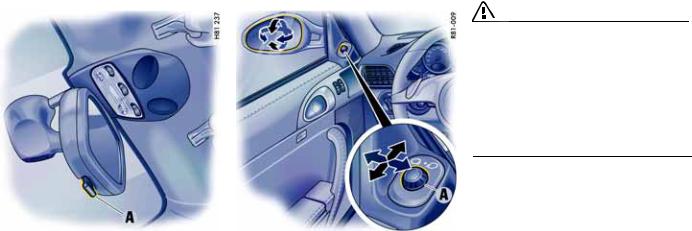
Mirrors
Inside mirror
When the mirror is being adjusted, the anti-glare lever A must point forward.
Basic position: lever forward Anti-glare position: lever back
Door mirrors
Before driving the vehicle, adjust the outside and inside mirrors.
It is important for safe driving that you have clear, unobstructed vision to the rear.
Warning!
Risk of an accident, resulting in serious personal injury or death.
fDo not put anything on or near the windows or the mirrors that may interfere with the driver’s vision.
Risk of damage to the door mirrors when washing the vehicle in a car wash.
f Fold in door mirrors before using the car wash.
Adjusting door mirrors
1.Switch on ignition.
2.By turning the control switch A, select the driver’s side or the passenger’s side.
3.Move the door mirror glasses in the appropriate direction by tilting the control switch.
If the electrical adjustment facility fails
f Adjust mirror by pressing on the mirror face.
Automatically swivelling down mirror on the passenger’s side
fPlease see the chapter “PARKING AIDS” on Page 72.
fPlease see the chapter “SEAT MEMORY” on Page 33.
Operation, Safety 27
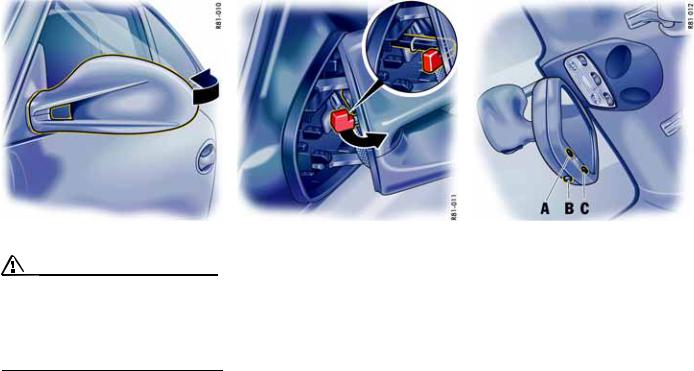
Folding in door mirrors
Warning!
Danger of injury to fingers if the mirror accidentally flips back when being folded in.
fExercise extreme caution when folding in mirror by hand. Do not let go of the mirror before the locking lever is locked or the mirror is fully unfolded.
28 Operation, Safety
1.Push mirror towards the door window and continue to hold it (high spring force).
2.Swivel the locking lever up to the stop and slowly let go of the mirror.
Unfolding door mirrors
1.Push mirror towards the door window and continue to hold it (high spring force). The locking lever disengages automatically.
2.Move mirror back to unfolded position by hand. Do not let go of the mirror beforehand.
A - Sensor
B - Switch for automatic anti-glare operation C - Light-emitting diode
Automatic Anti-Glare Interior
Mirror and Door Mirror
Sensors on the front and rear sides of the interior mirror measure the incident light.
The mirrors automatically change to anti-glare position or revert to their normal state, depending on the light intensity.
When reverse gear is selected, automatic antiglare operation is switched off.
